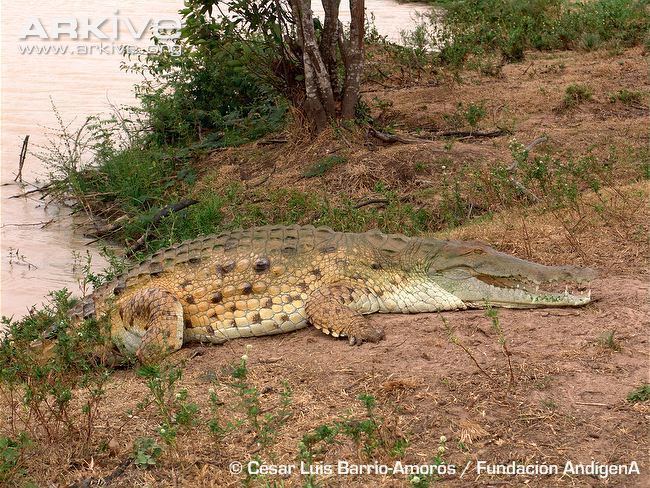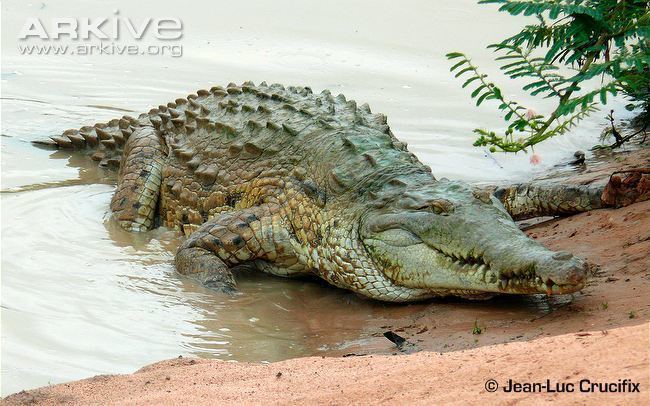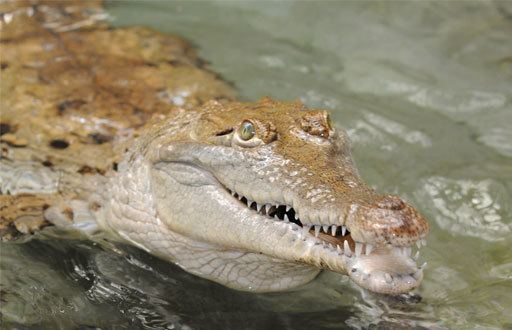Subfamily Crocodylinae Rank Species | Phylum Chordata Family Crocodylidae Higher classification Crocodylus | |
 | ||
Similar Crocodylus, Crocodile, Reptile, Crocodiles, Slender‑snouted crocodile | ||
Orinoco crocodile protects her nest deadly 60 series 3 bbc
The Orinoco crocodile (Crocodylus intermedius) is a critically endangered crocodile. Its population is very small and it can only be found in freshwater environments in Colombia and Venezuela, in particular the Orinoco River and its tributaries. Extensively hunted for their skins in the 19th and 20th centuries, this species is one of the most critically endangered species of crocodiles. It is a very large species, in fact the largest species of crocodilian and predator in the Americas. Males have been reported up to 6.6 m (22 ft) in the past, but such sizes do not exist today, 5.2 m (17 ft) being a more widely accepted maximum size. Males average at 4.1 m (13 ft) in length weighing 380 kg (840 lb), while females are slightly smaller averaging 225 kg (496 lb). Sexual dimorphism is not as profound as in some other species. The coloration is light even in adults.
Contents
- Orinoco crocodile protects her nest deadly 60 series 3 bbc
- Orinoco crocodile move
- Characteristics
- Size
- Distribution and habitat
- Hunting and diet
- Reproduction
- Conservation status
- References

The biology of the Orinoco crocodile is poorly documented in the wild, mostly due its small population. It is thought to have a more piscivorous diet with an opportunistic nature resulting in a generalist predatory behavior. The Orinoco crocodile is an apex predator and will take the opportunity to prey on a variety of reptiles, birds, and mammals, including caimans on occasion. The prey base is mostly made up of large predatory fish, challenging the general view by the locals complaining about the crocodile hunting local fish to very low numbers. Despite its large size, the Orinoco crocodile rarely poses a threat to humans, despite several reports. Reproduction takes place in the dry season when the water level is lower. Orinoco crocodiles are hole nesters, digging holes in the sand to lay their eggs. The females guard the nests and young up to several years.

Orinoco crocodile move
Characteristics

The Orinoco crocodile can be recognised by its relatively long snout, which is narrower than that of the somewhat similar-looking American crocodile. This species generally has a pale tan hide, though at least three coloration variations are known, with some almost completely yellowish and some a dark brownish-gray. The skin can change colour over long periods of time; this phenomenon has been recorded in other species that can gradually change the amount of melanin in their skin. These crocodiles have dark-brown markings, which present as more pronounced bands in younger specimens and as scattered markings on mature ones.
Size

The Orinoco crocodile ranks among the largest living reptiles, as well as the largest predator in the Americas. Typically, males are 3.6 to 4.8 m (12 to 16 ft) in length, weighing 380 to 635 kg (838 to 1,400 lb), while females are typically 3.0 to 3.3 m (9.8 to 10.8 ft) in length, weighing 225 to 317 kg (496 to 699 lb). The largest specimen reported was shot in 1800, and allegedly measured at 6.6 m (22 ft), although the source is considered reliable, unfortunately, no voucher specimen is known from this. Due to extensive hunting for their skins in the 20th century, such giants do not exist today, and modern Orinoco crocodiles have not been reported to exceed 5.1 m (17 ft) in length. Merchán listed the maximum total length attainable for a male as 5.2 m (17 ft) and the maximum length of a female as 3.6 m (12 ft). According to Guinness Records, the average length of adults that they were able to examine was only 3 m (9.8 ft) and the largest specimen found firsthand was 4.2 m (14 ft). It is arguably the largest crocodilian in the Americas, while American crocodiles and black caimans approach similar dimensions, on average the Orinoco crocodile is slightly longer.
Distribution and habitat

This species is restricted to the Orinoco River basin in Colombia and Venezuela. They have been occasionally reported on the island of Trinidad, but this has not been confirmed and witnesses may have mistaken an American crocodile for the rarer species. This crocodile was once thought to have inhabited a wide range of riparian habitats, from tropical forests to the streams of the Andes foothills. Today, this species is restricted to the Llanos savannah and associated seasonal freshwater rivers.
Hunting and diet

The majority of the Orinoco crocodile's diet consists of large fish, their relatively narrow snout being ideally suited to minimize water resistance in capturing prey. However, as an opportunistic apex predator, virtually any animal living within its range could be considered a potential meal, such as reptiles, birds, and mammals. Despite having a rather elongated skull, its base snout is wide, hinting to a generalist diet. It stalks both aquatic and terrestrial prey. As a large adult, terrestrial prey may include capybara, domestic animals, and even occasionally other large predators if the opportunity arises. Similar to many of the larger crocodile species, the Orinoco crocodile has also been observed catching and eating smaller species of crocodilians, such as caimans and sometimes cannibalizing smaller individuals of its own kind. Attacks on humans have been reported, but this is highly unlikely to be a common behavior, given the extremely small population of the species and its relative isolation from large human settlements. Its large size may pose a threat, but this species has a less aggressive temperament compared to other large crocodiles, which reduces the likelihood of it preying on humans.
Reproduction

When water recedes in the dry season, Orinoco crocodiles retreat to burrows they excavate into the riverbanks. The adult pair mates during the drier period of the year, and usually 14 weeks after mating, the female crocodile will dig a nest and lay about 40 eggs. It is a hole-nester and usually makes the nest on a sand bank. The eggs incubate for around three months. During the night, they hatch and call to their mother which digs them out of the nest and carries them to the water, which is considerably higher at this point. Young Orinoco crocodiles are often at risk from predation by American black vultures, tegu lizards, anacondas, caimans, coatis, jaguars, and other carnivores, though these species are sometimes caught and killed by the defending mother crocodile. Females have defended pods of juveniles for over three years, though closer to one year to independence is generally most common. A study of captive Orinoco crocodiles noted the aggressive behavior of adults while nesting and noted that the normally relatively docile crocodilians could not be approached while they were actively brooding.
Conservation status
The Orinoco crocodile is highly endangered due to excessive hunting for its hide. During the 1940s to the 1960s, thousands of these animals were slaughtered in the Orinoco River and the Llanos wetlands, and the species came very close to extinction. The Orinoco crocodile was given protected status in the 1970s, but has yet to recover. Today, it is protected both in Colombia and Venezuela, and also included on Appendix I by CITES. In addition to hunting for its hide, more recent threats include the collection of juveniles for sale in the live animal trade, pollution, and the proposal of a dam in the upper Orinoco River region. Another problem is the increased population of spectacled caimans, a smaller crocodilian that can outcompete the Orinoco crocodile for fish due to its much larger population and much more accelerated breeding rates.
It is unclear how many individuals remain in the wild, but estimates range between 250 and 1500. The largest subpopulation in Venezuela is in Cojedes and Sarare, with less than 500 adults remaining. A number of other smaller subpopulations exist.
In November 2007, 50 individuals were held in zoos registered by ISIS, of which the largest population, 35 individuals, were kept in the Dallas World Aquarium. Additionally, a large number of individuals are held at captive-breeding facilities in Venezuela. Since the early 1990s, a large number of hatchlings have been released both into private ranchlands (especially in the Llanos where nature-oriented tourism is important for the local economy) and in national parks in Venezuela. While six Venezuelan captive-breeding programs continue today, many are plagued by lack of funds or staff, as well as conflicts between private and state-owned facilities.
The Orinoco crocodile became part of Proyecto Vida Silvestre, a program launched in 2014 to protect 10 wildlife species of Colombia's Llanos. Thanks to that program, between May 2015 and February 2016, 41 orinoco crocodiles were reintroduced at El Tuparro National Natural Park in eastern Colombia.
